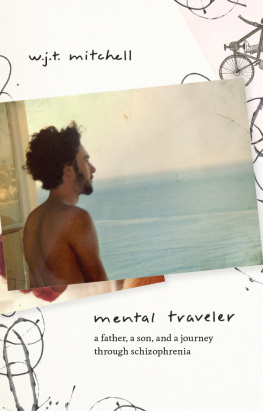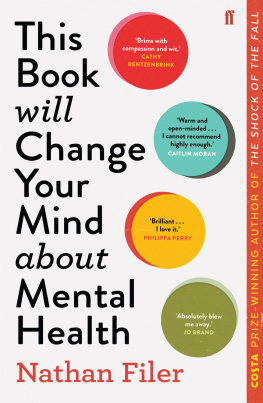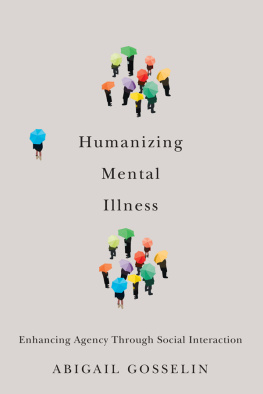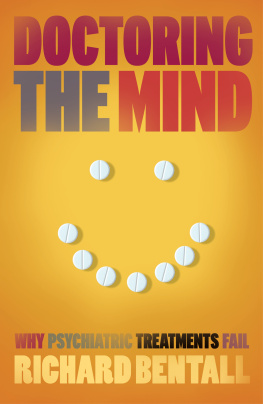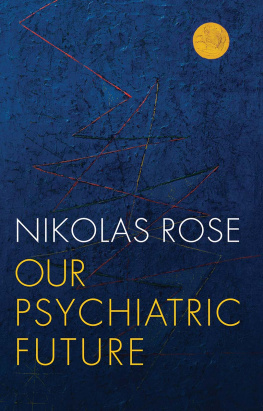INSIDE
THE MENTAL
Silence, Stigma, Psychiatry, and LSD
Kay Parley

2016 Kay Parley
All rights reserved. No part of this work covered by the copyrights hereon may be reproduced or used in any form or by any means graphic, electronic, or mechanical without the prior written permission of the publisher. Any request for photocopying, recording, taping or placement in information storage and retrieval systems of any sort shall be directed in writing to Access Copyright.
My own experiences related in Inside The Mental are factual, but some of the names and details concerning other patients and staff at the hospital have been altered to protect their privacy.
Printed and bound in Canada at Friesens .
Cover and text design: Duncan Campbell, University of Regina Press
Copy editor: Joan McGilvray Proofreader: Kristine Douaud
Cover photo: Carrie Fijal Kaye / Snapwire
Library and Archives Canada Cataloguing in Publication
Parley, Kay, author
Inside the mental : silence, stigma, psychiatry, and LSD / Kay Parley.
(The Regina collection)
Parts of this work were included in Lady with a lantern.
= Issued in print and electronic formats. ISBN 978-0-88977-411-7 (hardback).
ISBN 978-0-88977-413-1 (html). ISBN 978-0-88977-412-4 (pdf)
1. Parley, KayHealth. 2. Weyburn Mental HospitalHistory. 3. PsychiatrySaskatchewanHistory. 4. LSD (Drug)Therapeutic useSaskatchewanHistory. 5. Psychiatric nursesSaskatchewanBiography. 6. Psychotherapy patientsSaskatchewanBiography. I. Title. II. Series: Regina collection
RC448.S33W49 2016 362.2'1097124 C2016-900155-5 C2016-900156-3

Saskatchewan, Canada, S4S 0A2
tel: (306) 585-4758 fax: (306) 585-4699
web : www.uofrpress.ca
0 9 8 7 6 5 4 3 2 1
We acknowledge the support of the Canada Council for the Arts for our publishing program. We acknowledge the financial support of the Government of Canada. / Nous reconnaissons lappui financier du gouvernement du Canada. This publication was made possible through Creative Saskatchewans Creative Industries Production Grant Program.



To anyone and everyone
who fights the stigma
Kathleen
She was just a half a person,
Six or seven, skinny, meek,
Heart a mass of fissures, brain in prison,
Will is weak;
Flailing at a foreign world,
Eating gall and drinking tears,
Hidden from reality through
Fifty bitter years.
How hard its been to help her,
Shes the saddest thing Ive seen
But its harder still to realizeadmit
That Im Kathleen.
From The Multiple Personality Poems by Kay Parley
Contents
Acknowledgements
The people who contributed indirectly to this book are too numerous to list and, since I am ninety-three, not many will be alive to read their names. But I want to express gratitude to those who helped me through my 1948 breakdown: my mother, who made sure I received treatment, Dr. R. J. Weil, Dr. Z. Selinger, and so many of the staff at the Weyburn mental hospital. Then there are those who eased mein fact boosted methrough the difficult time of rehabilitation: Larry Lowes, Jean Arnett Freeman, Mavis Jahnke, and N. R. MacDonald. There were many more. I wish I had room to thank all those who offered support and stimulation, enriching my training as a registered psychiatric nurse: especially Dr. Humphrey Osmond, Francis Huxley, and Dr. Gwyn Gilliland. For the camaraderie I found at University Hospital, thank you to all.
A big thank you to my publisher, Bruce Walsh of University of Regina Press for the sensitivity he has shown in seeing potential value in these stories. Thank you, too, to Joan McGilvray for the great job she did selecting passages from my writing to be included in the book. As for my editor, David McLennan, I cant imagine finding anyone more compatible and understanding. Working with him has been a terrific experience.
To all those who helped me live this story and to those who have done so much to organize and prepare the book, my most sincere thank you.
Introduction
The stories in this book cover a fairly wide spectrum in time and subject matter, from treatments available in the mental hospital at Weyburn, Saskatchewan, in 1948 to what it was like to do psychiatric nursing in the same hospital during the enlightened fifties, to a peek at the fascinating research being done with lsd in the sixties. Perhaps the unity to be found in the stories is the writer herself, because I had the good fortune to experience all of that.
Mental illness was always part of my life. When I was born, my maternal grandfather, diagnosed as paranoid, was already in the Weyburn hospital, which was commonly called The Big Mental or The Mental. I had never seen my grandfather, so his absence didnt make a difference to me, but when I was only six my father was taken to the same hospital with a diagnosis of manic-depressive psychosis. My world shattered. Id been a Daddys girl, so I lost much of the love in my life at that tender age. I handled it in one of the worst ways possible, by repression. My emotions froze. I remembered almost nothing of the days when Dad had been at home, nothing at all of the anguish Id endured when I found that he was gone. Forgetting saved me from disintegration, and the fact that my intellectual and creative capacities were unharmed enabled me to carry on fairly normally and to do well in school. Still, emotional instability is destructive. By the time I was twenty-four Id changed careers four or five times, lost the one serious love of my life, and developed a multiple personality. I never split, as happens in extreme cases of multiple personality, but one of the girls living in me led me up false paths for years, because she was determined to be an actress and I was neither talented enough nor motivated enough to be a success in drama.
People seldom realized how depressed or confused I could be, so I took a lot of criticism. A psychiatrist once told me I gave people the wrong signals, so it was my own fault if I was misunderstood. My mother had a very high iq and held reason in high regard, but she had no time for emotion, so I got almost no emotional support. In 1948, while doing office work at cbc Radio in Toronto, I fell apart. My practical mother whisked me home to Saskatchewan and got me into treatment.
That is when I finally met my father and my grandfather and when I learned what a mental hospital was really like. The first thing my psychiatrist explained was that I had ceased to develop emotionally at the age of seven. I was now twenty-five. I had lost eighteen years, and he told me it would take eighteen years to catch up. It did.
I cant say I loved the mental hospital without misgivings. It was crowded, noisy, smelly, shabby, with too much authority around and too many people who behaved in threatening or in particularly unintelligent ways. But in many ways I loved The Big Mental. It was home to so many people, and some of the old-timers were very receptive. We had therapists who were warm, friendly, understanding, and encouraging. After nine months I was discharged from the admitting ward to work in Weyburn. The city was used to mental patients and I was welcomed into a rooming house where I felt right at home. I joined an art class, helped start a little theatre, and felt better than I ever had. I worked in a law office and was doing well, but then the newly formed Saskatchewan Arts Board offered me a job and I thought I should return to Regina. Two years later, in 1954, I was back in Toronto and...!!! Another breakdown.
Next page


